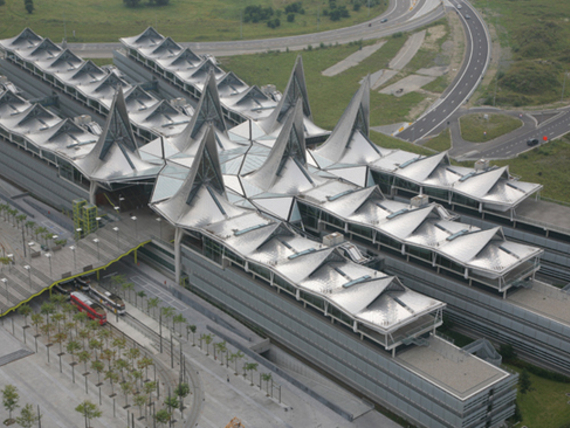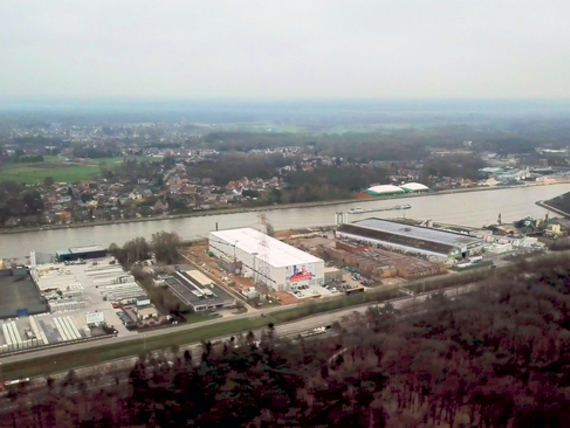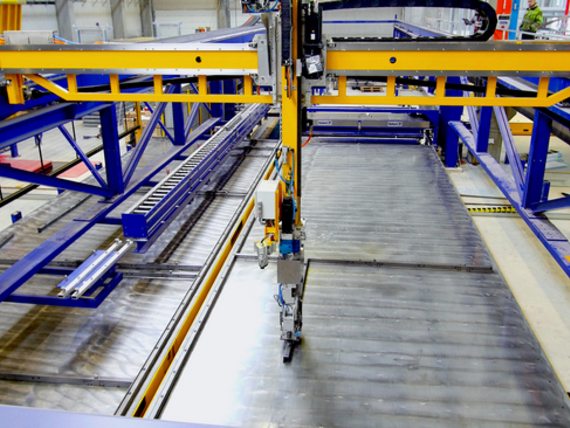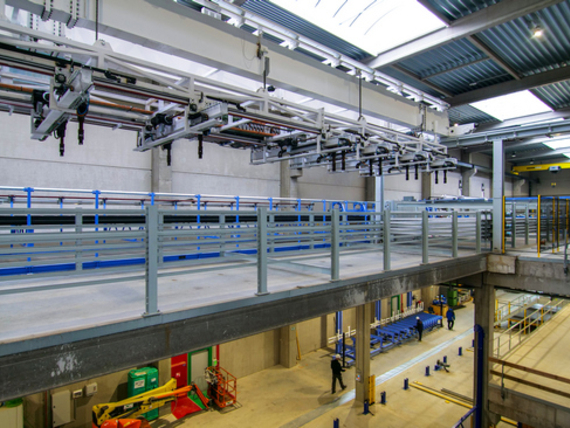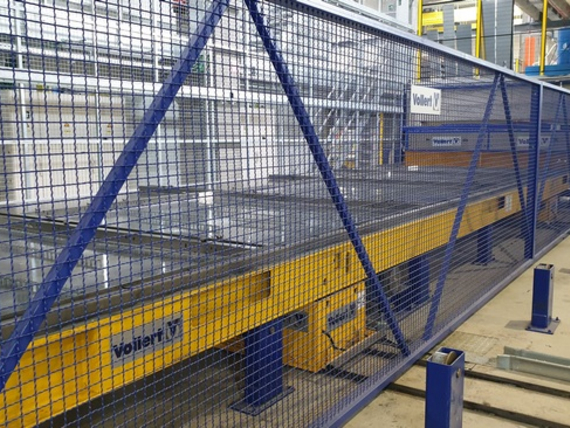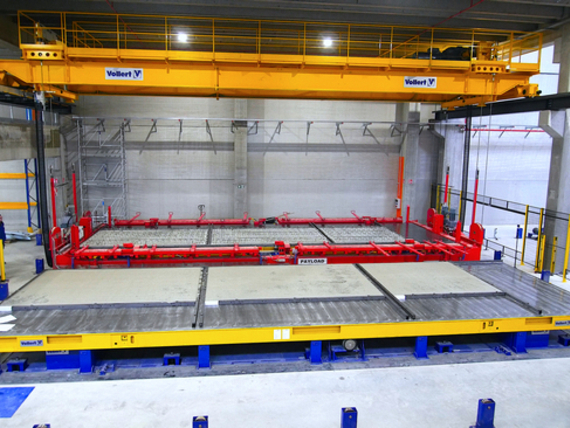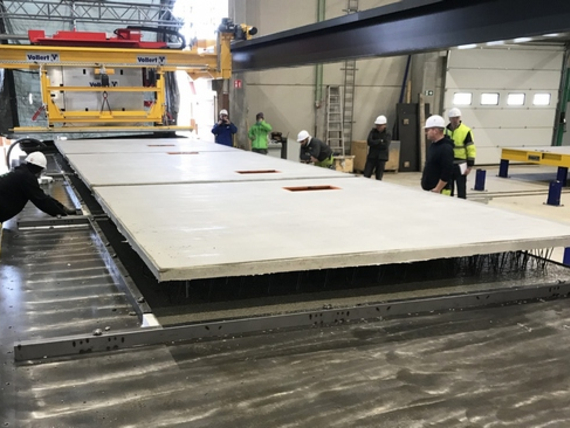The Belgian Kerkstoel Group is one of Europe's leading manufacturers of ready-mixed concrete and precast concrete parts. Since the 1980s, the traditional company has been doing real pioneering work in the production of state-of-the-art, automated semi-finished precast concrete elements with its subsidiary Kerkstoel 2000+. As early as 1989, one of the world's first industrial series production plants for floor slabs with plant technology from Vollert was built in Grobbendonk near Antwerp in Flanders. The year 1997 marked the entry into double wall production, especially for modern residential and industrial construction.
Today, Kerkstoel, under its chairman Pascal Kerkstoel, is considered a pioneer and driver of innovation in excellent architecture with precast concrete elements. "This ranges from the Ericsson headquarters in Zaventem, the Eurostation II central station in Brussels to the justice building in Antwerp. A real architectural highlight" is how Pascal Kerkstoel describes it, not without a little pride. He can certainly be proud, because what has been built in Grobbendonk over the past 30 years is exemplary. Countless architectural highlights and real estate projects in the Benelux countries have been built with precast concrete elements produced in Grobbendonk.
In 2019 the modern precast concrete plant of the 21st century will be built
Pascal Kerkstoel is firmly convinced that "standing still is always a step backwards". Today, walls, floor slabs or facade components are not only considerably more diverse in terms of architecture, shapes or surface qualities, but also require larger work contents, more built-in parts or integrated special functions. At the same time, the necessary capacities for construction projects are becoming larger and the cost pressure is increasing in order to remain competitive for customers and orders. These developments are a major challenge for many precast concrete manufacturers. "Since our customer inquiries are also increasingly directed at double and solid wall elements with complex component geometries and oversized wall surfaces of up to 3.80 m, we decided to invest in another modern precast concrete production line in 2018. Certainly the biggest investment in our history to date".
The plant concept and layout were developed by Prilhofer Consulting as an independent consulting company. After all plant and performance requirements had been defined, a specification document was prepared for each part of the machine technology. On the basis of this document, Kerkstoel 2000+ and Prilhofer Consulting carried out a tender for the plant technology, in which the German concrete plant specialist Vollert together with RIB SAA Software Engineering and its local partner UBO Engineering were able to successfully position themselves against the competitors. The implementation planning and project management was also carried out by Prilhofer Consulting, in close coordination with the Vollert project team.
"The plant concept developed by Prilhofer Consulting is certainly very unusual and probably unique in Europe", describes Philippe Marrié as Executive Sales Director for the Benelux at Vollert. "From the very beginning of the planning, we have intensively dealt with the requirements of Kerkstoel and Prilhofer Consulting. In order to manufacture serial products such as large-area wall elements for industrial building projects, but also architectural concrete parts or walls with special dimensions or surfaces on the same transport line, industrial prefabrication requires an intelligent plant concept for flexible processes as well as high automation with the latest robot technology", Philippe Marrié describes. The production of complex special concrete parts also requires a greater amount of work. However, this would mean a longer dwell time, for example in the reinforcement or in the manual processes for walls or slabs with integrated cabling or with special surface coating. In order to solve this challenge, to be as flexible as possible and still achieve extremely high plant productivity, new production technology processes were required. "Another challenge was to plan the plant concept in a maximum of compactness, since the location of the Kerkstoel plant on the side bank of the Albert Canal means very expensive building land. Above all, storage space is minimized, there is a daily turnover of the produced walls and floor slabs" explains Jürgen Schäfer, project manager at Vollert. "The objective was to achieve a concreted wall and floor slab area per year of up to 500,000 m², on a given base area of 4,880 m²".
Island method, "double bottom" and maximum automation
In order to be as flexible as possible and at the same time avoid long downtimes or waiting times for individual manual activities for the complex wall and floor slab geometries, the island method was chosen. Here, individual circulating pallets are ejected from the line production into separate buffer areas before the concreting process or after the robot-supported reinforcement process, separated by special vertically movable barrier fences. "Depending on the construction project and the degree of capacity utilisation, the necessary manual preparation work is carried out here, such as the insertion of special reinforcement elements, built-in components such as sockets and window frames or pipework. With these net-like work islands we are more flexible by a factor of 3, Pascal Kerkstoel describes. The following, less complex wall parts or floor slabs can be transported further in the line without the total flow coming to a standstill and without reducing the plant productivity.
In some cases, the circulating pallets travel tunnel-like under a higher intermediate level. "The fact that we at Kerkstoel work on several levels is certainly a highlight of the plant design", explains Jürgen Schäfer. Due to the geographical conditions directly at the Albert Canal near the water, building ground was limited right from the start. "Therefore, different working levels and platforms were provided" he adds. The entire fully automated reinforcement preparation takes place on a higher intermediate level. "Here we are almost 15 m above the ground." The AWM reinforcement machine prepares a wide variety of reinforcement meshes and lattice girders CAD/CAM-controlled for the next walls and floor slabs. A reinforcement robot uses a special lifting and lowering function to position these through a slab recess directly onto the circulating pallet passing below for the subsequent concreting process. The future surface finishing of the wall and floor slab surfaces is located on the same intermediate level. The VArio STORE storage and retrieval machine takes over the pre-hardened upper shell or the solid concrete element from the hardening chamber and transports it directly to the opposite intermediate level. In a further expansion stage, a finishing line with several electric VArio SMOOTH surface smoothing machines is planned.
The intelligent MES production system from the automation specialist RIB SAA Software Engineering ensures that construction sites and customers are supplied with the necessary precast concrete elements in an optimal and punctual manner. It continuously controls and monitors all processes and machines in the precast concrete plant, from work preparation and work stations to storage and loading processes. It is the central interface for the construction data from the BIM model and the existing ERP system. Throughput times and automated pallet allocation are permanently optimised, all machines are controlled, data is automatically tracked and prepared, retrieval sequences and curing times are managed and a large number of statistics are provided. In a Smart Factory like Kerkstoel 2000+, this runs completely paperless. Component drawings, occupancy plans, order stacks or the current stock levels are always prepared in a visualized way and can be called up by means of the most modern hardware, such as tablets or large multi-touch flat screens.
Robot and laser technology for highest precision
Today, an ever-increasing degree of automation in precast concrete plants is provided above all by precise high-performance robots, turning and transport devices as well as fully automated indexing of all processes and transport routes. This is not only important in terms of plant productivity, but also ensures consistently high quality standards and less concrete and material waste, thus leading to greater resource efficiency.
Robotics combined with state-of-the-art laser technology, permanent quality checks and a zero-defect strategy are the keywords here. The SMART SET2 shuttering robot is a multi-functional robot of the latest generation that combines innovative technology with high performance values in terms of travel speed and acceleration. On the SMART SET robot line at Kerkstoel, the up to 500 mm high shuttering systems are positioned under CAD/CAM control, depending on the wall or floor slab type, and, if required, the contours for built-in parts and reinforcement components are preplotted. For the de-shuttering process, optical scanning systems scan the surface and register the type and position of the shuttering profiles before the SMART SET removes them and, after the cleaning process, places them in the storage magazines or on the feed line to the next shuttering process. Five iTWO SMART LASER projection systems are installed along the transport line for permanent quality control and monitoring of the tolerances to be maintained, for example, during manual reinforcement supplementation.
Another important quality factor for the later wall quality is the concreting process. A fully automatic, bridge-guided SMART CAST concrete distributor ensures optimum concrete cycle times and exact concrete metering in accordance with the zero-error strategy. Under- or over concreting of the desired discharge quantity is reduced and this is done in a process-safe manner with a very high availability. The compaction of the concrete by means of a combined VArio COMPACT2 shaker/vibrating station guarantees an optimum upper shell of the solid concrete elements in fair-faced concrete quality, as well as ideal compaction of the more heavily reinforced supporting shell in double and sandwich walls. A further shaking station is installed in the area of the turning device. The low-frequency vibratory movement is generated by four unbalance drives and thus compacts the concrete. Depending on the dead weight of the concrete element, the compaction energy is automatically adjusted. This enables an optimal, circular vibrating movement with low noise emission. An insulated VArio CURE curing chamber with 4 rack towers with a total of 56 curing places ensures an energy-efficient curing process. A special heat circulation system ensures even temperature distribution.
Important technical innovations to increase cycle times and in the areas of ergonomics and work safety were realized at Kerkstoel 2000+ in double and sandwich wall production. Traditionally, the clamping arms for pre-locking the first shell before the turning process are manually inserted and also removed again. This is not only time-consuming, but also a heavy physical strain due to the high dead weight of the clamping arms. With the VArio TURN turning device at Kerkstoel, clamping arms remaining directly on the turning device ensure that the first shell of the double/sandwich wall is held securely on the turning crossbeam during the lifting and turning movement. Optionally, an automatic wall thickness adjustment can automatically take over and adjust the height of the double wall. The height of the clamping arms can also be variably fixed, so that nothing stands in the way of the production of core-insulated double walls. The pre-fixing of the first to the second shell is carried out precisely in all positions.
Kerkstoel Group sets another milestone
"Kerkstoel 2000+ has set a further milestone with the new precast concrete plant in Grobbendonk" says Philippe Marrié with conviction. Since the end of 2019, high-quality double walls have already been produced for several prestige construction projects in the Antwerp area, but also in the other Benelux countries. Special customer designs or special concrete parts, as well as large series for large-scale construction projects can now be produced simultaneously. "Technology, great know-how, maximum quality and absolute adherence to delivery dates, our customers can continue to rely on this", explains Pascal Kerkstoel with regard to the further growth of his traditional family business and pioneer in precast concrete part production.




